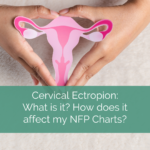
Fasting, Periodic Abstinence, and Body Literacy
February 15, 2024
Cervical Ectropion and NFP Charting
April 11, 2024Luteinized Unruptured Follicles (LUF)
As an NFP Instructor, I frequently have clients who are worried that they might be experiencing Luteinized Unruptured Follicles (LUFs). They are concerned that a LUF here or there is going to throw their charting for a loop. Or they try to dissect patterns in their charts to see if they can spot a LUF. Sometimes, it feels like LUFs are a sort of bogeyman in NFP charting—something discussed on Facebook group threads which shake women and couples to the core with worry.
I'll explain in a little bit about why LUFs are important to know about in the context of trying to conceive, but first let's start with the basics.
What is a LUF?
In the context of a menstrual cycle, follicles are stimulated within the ovary to begin maturing eggs (ova). At some point, a dominant follicle is selected for that cycle and that is the follicle which will fully mature its egg for release at ovulation. Sometimes each ovary selects a dominant follicle and two eggs could potentially be released, which is the biological basis for fraternal twins.
When that follicle is "ripe" (so to speak) and ready to release its egg, a pituitary hormone comes along to help that follicle open up and undergo a structural change.
Are you ready for a completely circular definition?
Okay... the pituitary hormone is called Luteinizing Hormone, because it transforms the follicle into a new structure called the corpus luteum (the "yellow body," in Latin). This process is called "luteinization" (literally, "the yellowing") and is depicted below:

Image source: https://www.frontiersin.org/journals/endocrinology/articles/10.3389/fendo.2019.00774/full
What usually happens is that the process of luteinization results in the breakdown of various membranes and structures such that the follicle OPENS and releases the egg that has been maturing inside it. This is called OVULATION. In its new form, the corpus luteum is able to produce a hormone called progesterone, which is necessary for the early stages of pregnancy and helps with preparing the uterine lining for the possibility of pregnancy.
In NFP methods, the presence of progesterone can be monitored through Basal Body Tracking (to find a temperature shift), through PdG urine testing, or through family planning blood draws. USUALLY the confirmation of progesterone with one of these signs means that ovulation has successfully occurred.
BUT, in some rare cases, it's possible for a follicle to undergo the process of luteinization without actually releasing that egg. In this case, the egg is not viable and remains "trapped" inside the corpus luteum until the corpus luteum breaks down and a new cycle begins. That is what happens when you have a Luteinized Unruptured Follicle.
Why are LUFs a problem?
Experiencing a single LUF is usually not a problem. Menstrual cycles aren't perfect and in my own practice, I typically tell clients not to worry about a single occurrence of any one particular issue because... things happen. Our cycles are considered "vital signs" because they do reflect our overall health and can be impacted by lots of things. And for the most part, our bodies make healthy adjustments to diet, stress, sickness, travel... you name it. We may feel that something is "off" for a little bit, but then things go back to normal.
If you're trying to postpone pregnancy, it's likely you wouldn't even notice the presence of a LUF at all. Your body will still be experiencing all the cyclical hormone changes just as if ovulation had occurred, because all the necessary elements are there. And for the purposes of avoiding pregnancy, it won't negatively impact the efficacy of your NFP method at all to have the egg be unreleased.
Where LUFs become problematic is when they start becoming more frequent and can actually be identified as a recurring syndrome. This is what the acronym LUFS stands for-- Luteinized Unruptured Follicle Syndrome.
It's a key factor in many instances of infertility, because obviously if your eggs are "trapped" inside the corpus luteum most cycles, they can't become fertilized.
How Do I Know if I'm Having LUFs?
By now, it should be fairly obvious that you can't really find LUFs in a basic NFP chart. Everything happens "according to plan" in the first half of the cycle and the follicle undergoes the process of luteinization-- so all of your hormones are going to look very similar to a cycle in which the egg is actually released. In some cases, LUFs might be suspected if the progesterone response looks weaker than normal, or if your luteal phase (the time after ovulation) is decreased a little bit (see: https://pubmed.ncbi.nlm.nih.gov/8671271/) But if you are regularly experiencing LUF's, you can't suss out a change in your charts because a lot of your charts will just look that way normally.
So the only real way to get this diagnosed is by serial ultrasound or even laparoscopic analysis.
But LUFs should be a part of the conversation with your doctor if you are experiencing infertility, especially in the presence of other conditions like endometriosis or PCOS, which are often associated with LUFS.
❤️ Loved this post? Be sure to subscribe to the Body Lit Library weekly newsletter, where every Thursday you'll get access to new content, updates, and special insider offers!
📚 Want to learn more? Check out our lifelong body literacy education courses and books, from puberty through perimenopause and everything in between: pearlandthistle.com


